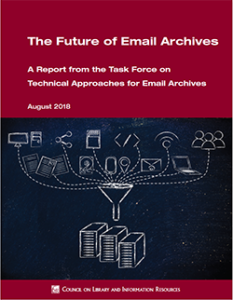Task Force identifies short- and long-term actions for advocacy
and technology development
Contact: Kathlin Smith
202-939-4754
Washington, DC, August 13, 2018—Email is an increasingly important part of the historical record, yet it is particularly difficult to preserve, putting future access to this vast resource at risk. A new report from the Council on Library and Information Resources (CLIR) looks at what makes email archiving so complex and describes emerging strategies to meet the challenge.
 The Future of Email Archives presents the findings of a yearlong investigation of the Task Force on Technical Approaches for Email Archives, sponsored by The Andrew W. Mellon Foundation and the Digital Preservation Coalition. The 19-member task force, comprising representatives from higher education, government, and industry, was co-chaired by Christopher Prom, of the University of Illinois at Urbana-Champaign, and Kate Murray, of the Library of Congress.
The Future of Email Archives presents the findings of a yearlong investigation of the Task Force on Technical Approaches for Email Archives, sponsored by The Andrew W. Mellon Foundation and the Digital Preservation Coalition. The 19-member task force, comprising representatives from higher education, government, and industry, was co-chaired by Christopher Prom, of the University of Illinois at Urbana-Champaign, and Kate Murray, of the Library of Congress.
More than 2.6 billion people currently use email; on an average day 215 billion messages are sent and received for personal and business communication. Email documents personal and public stories, yet relatively few archives have policies in place for systematically capturing, preserving, and providing access to email. Complexity is part of the problem. “Email is not one thing, but a complicated interaction of the technical subsystems for composition, transport, viewing and storage,” notes the report.
“Archives can and should do everything they can to capture and preserve email, if we want to assemble a historical record that future generations can interrogate and use,” said Prom.
Some archives have made progress in creating preservation workflows, and the report includes examples from five institutions. Most archives, however, are being left behind. “Just as the protocols that define the email environment are heavily standardized to facilitate interoperability across the diverse landscape of email, so too must the tools to preserve email be able to interact with one another across the lifecycle,” write the authors.
“Some protocols and tools already exist but their functionality is not yet mature and there is much work ahead to implement scalable, community-led solutions,” adds Murray.
Addressing the challenges will require commitment and engagement from a wide variety of stakeholders. The task force proposes a series of short- and long-term actions for community development and advocacy, as well as for tool support, testing, and development.
The report is intended for the archival community, digital preservation professionals, technologists and software developers, commercial vendors, historians and scholars, institutional administrators, and funding agencies and foundations. Print and online versions are available via https://www.clir.org/pubs/reports/pub175.
CLIR is an independent, nonprofit organization that forges strategies to enhance research, teaching, and learning environments in collaboration with libraries, cultural institutions, and communities of higher learning. It aims to promote forward-looking collaborative solutions that transcend disciplinary, institutional, professional, and geographic boundaries in support of the public good.

